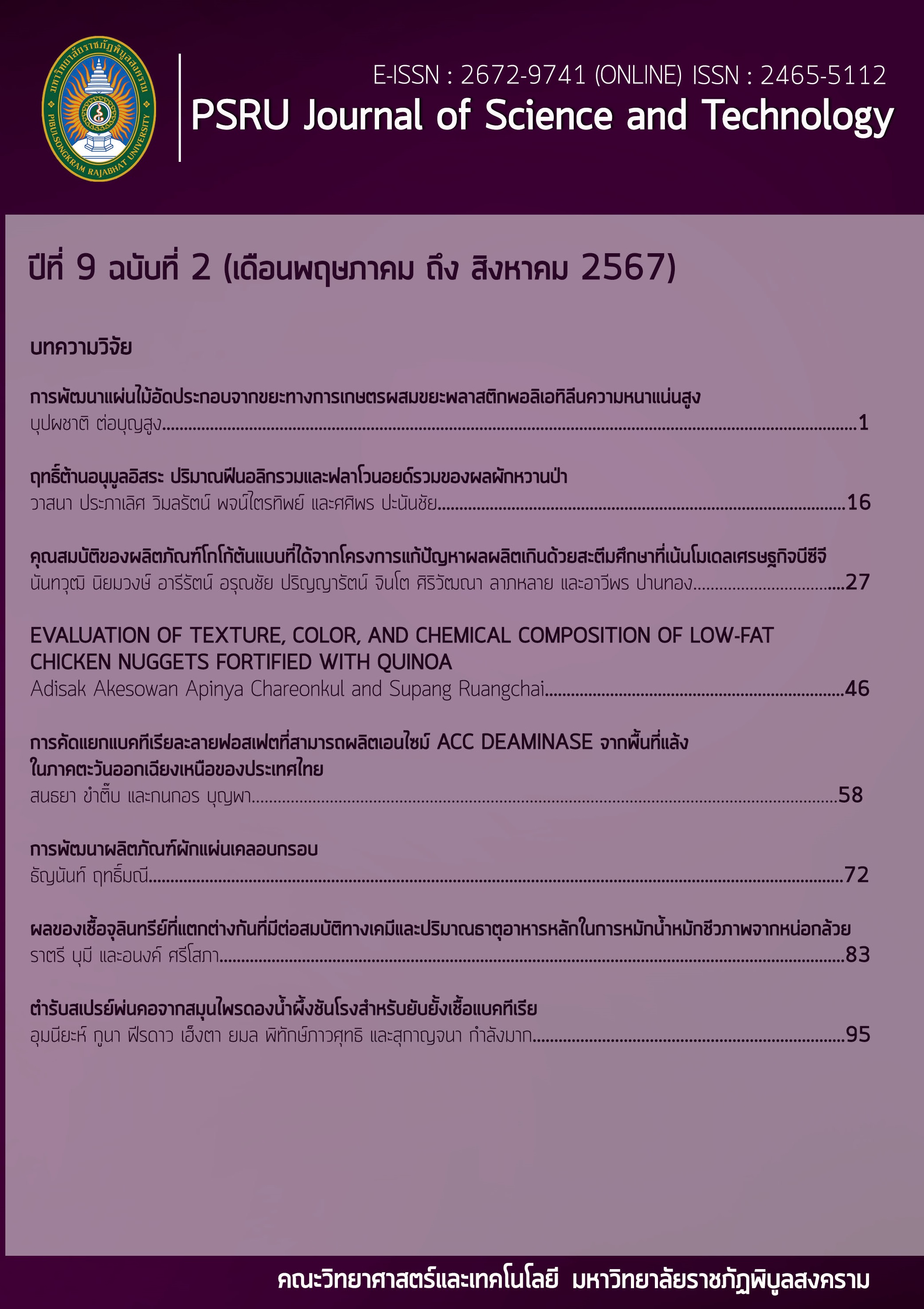EVALUATION OF TEXTURE, COLOR, AND CHEMICAL COMPOSITION OF LOW-FAT CHICKEN NUGGETS FORTIFIED WITH QUINOA
Keywords:
Chicken nugget, Color, Functional food, Quinoa, TextureAbstract
Superfood quinoa can be utilized to produce novel, healthful meat products that are crucial for lowering the risk of chronic illnesses. Four low-fat, konjac-based nuggets fortified with 10% to 40% quinoa, viz., the control (without quinoa), were assessed for their textural properties and color chromaticity. In comparison to the control nugget, incorporating 10% quinoa increased the nugget's textural characteristics, including hardness, cohesiveness, springiness, and chewiness but lower lightness. Increasing to 20% to 40% quinoa made the nuggets have more deteriorated textural characteristics and a darker color. The use of quinoa can increase the fiber content and reduce the protein content of the nuggets. The finding reveals that the optimal addition of 10% quinoa can improve the nugget’s texture and fiber content. This provides basic information that has the potential to be scaled up to the industrial level.
References
Akesowan, A. (2016). Production and storage stability of formulated chicken nuggets using konjac flour and Shiitake mushrooms. Journal of Food Science and Technology, 53(10), 3661–3674.
Akesowan, A. (2021). Partial salt reduction in gluten-free chicken nugget extended with white button mushroom and quality development with eggplant flour. Journal of Food Science and Technology, 58(12), 4738–4745.
Alkobeisi, F., Varidi, M.J., Varidi, M., & Nooshkam, M. (2022). Quinoa flour as a skim milk powder replacer in concentrated yogurts: Effect on their physicochemical, technological, and sensory properties. Food Science and Nutrition, 10(4), 1113–1125.
AOAC. (2019). Official Methods of Analysis of the Association of Analytical Chemists. (21st editon). Washington DC: Association of Analytical Chemist.
Cruz-Requena, M., Aguilar-González, C.N., Prado-Barragan, L.A., Carneiro-da Cunha, M. das G., dos Santos Correia, M.T., Contreras-Esquivel, J.C., & Rodríguez-Herrera, R. (2016). Dietary fiber: An ingredient against obesity. Emirates Journal of Food and Agriculture, 28, 522–530.
Elleuch, M., Bedigian, D., Roiseux, O., Besbes, S., Blecker, C., & Attia, H. (2011). Dietary fibre and fibre-rich by- products of food processing: Characterisation, technological functionality and commercial applications: A review. Food Chemistry (124), 411–421.
Fernández-López, J., Lucas-González, R., Roldán-Verdú, A., Viuda-Martos, M., Sayas-Barberá, E., Ballester- Sánchez, J., Haros, C.M., & Pérez-Álvarez, J.A. (2020). Effects of black quinoa wet-milling coproducts on the quality properties of Bologna-type sausages during cold storage. Foods, 9(3), 274.
Krzywdzinska-Bartkowiak, M., Piatek, M., & Kowalski, R. (2022). The influence of the rotational speed of the meat cutter knives and bowl on the microstructure of meat products. Scientific Reports, 12(1), 15492.
Kyriakopoulou, K., Keppler, J.K., & van der Goot, A.J. (2021). Functionality of ingredients and additives in plant-based meat analogues. Foods, 10, 600.
Lee, C.H., & Chin, K.B. (2019). Evaluation of physicochemical and textural properties of myofibrillar protein gels and low-fat model sausage containing various levels of curdlan. Asian-Australasian Journal of Animal Sciences, 32(1),144–151.
Lestari, L.A., Rohman, A., Riswahyuli, Purwaningsih, S., Kurniawati, F., & Irnawati. (2022). Analysis of amino acids in food using High Performance Liquid Chromatography with derivatization techniques: a review. Food Research, 6, 435–442.
Mehta, N., Ahlawat, S.S., Sharma, D.P., & Dabur, R.S. (2015). Novel trends in development of dietary fiber rich meat products—a critical review. Journal of Food Science and Technology, 52, 633–647.
Mordor intelligence. (2023). Food fiber market size 2023-2028. Retrieved September 26, 2023, from https://www.mordorintelligence.com/industry-reports/food-fibers-market
Öztürk-Kerimoğlu, B., Kavuşan, H.S., Tabak, D., & Serdaroğlu, M. (2020). Formulating reduced-fat sausages with quinoa or teff flours: Effects on emulsion characteristics and product quality. Food Science of Animal Resources, 40(5), 710–721.
Park, J.H., Lee, Y.J., Lim, J.G., Jeon, J.H., & Yoon, K.S. (2021). Effect of quinoa (Chenopodium quinoa willd.) starch and seeds on the physicochemical and textural and sensory properties of chicken meatballs during frozen storage. Foods, 10(7), 1601.
Sayas-Barberá, E., Valero-Asencio, M.M., Rodríguez-Vera, C.N., Fernández-López, J., Haros, C.M., Pérez-álvarez, J.Á., & Viuda-Martos, M. (2021). Effect of different black quinoa fractions (Seed, flour and wet-milling coproducts) upon quality of meat patties during freezing storage. Foods, 10(12), 3080.
Vázquez-Orttz, F.A., Caire, G., Higuera-Ciapara, I., & Hernández, G. (1995). High Performance Liquid Chromatographic Determination of Free Amino Acids in Shrimp. Journal of Liquid Chromatography, 18(10), 2059–2068.
Verma, A.K., Rajkumar, V., & Kumar, S. (2019). Effect of amaranth and quinoa seed flour on rheological and physicochemical properties of goat meat nuggets. Journal of Food Science and Technology, 56(11), 5027–5035.
Downloads
Published
How to Cite
Issue
Section
License
Copyright (c) 2024 PSRU Journal of Science and Technology

This work is licensed under a Creative Commons Attribution-NonCommercial-NoDerivatives 4.0 International License.
กองบรรณาธิการขอสงวนสิทธิ์ในการปรับปรุงแก้ไขตัวอักษรและคำสะกดต่างๆ ที่ไม่ถูกต้อง และต้นฉบับที่ได้รับการตีพิมพ์ในวารสาร PSRU Journal of Science and Technology ถือเป็นกรรมสิทธิ์ของคณะวิทยาศาสตร์และเทคโนโลยี มหาวิทยาลัยราชภัฏพิบูลสงคราม และ
ผลการพิจารณาคัดเลือกบทความตีพิมพ์ในวารสารให้ถือมติของกองบรรณาธิการเป็นที่สิ้นสุด







